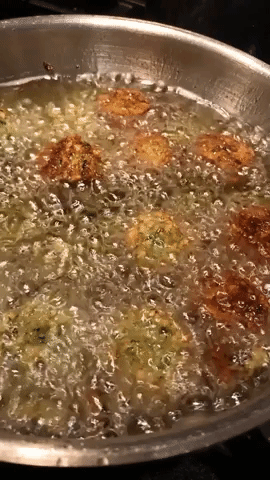Dirt cheap… mind blowingly versatile… high in protein… an infinite shelf life… yes, this miracle ingredient exists. It’s the ultimate legume that’s available in virtually every grocery store there is. Say hello to the dried chickpea. My favorite application? The crispy, crunchy, salty, herby, garlicky, extremely satisfying deep fried ball of vegan protein - otherwise known as the falafel.
The equation is soo simple… Soak dried chickpeas, grind with flavorings, shape, and fry until golden brown. Boom, you have falafel... You’re chances of success are high.
Before you ask… no, you cannot use canned chickpeas. In fact, you actually need dried chickpeas for a proper falafel. Canned chickpeas are fully cooked and thus tender right out of the can. These make a convenient add-in to mediocre salads, but try grinding them up and you will find yourself with something that resembles shitty hummus. The trademark, “ideal” texture of falafel is coarse, crunchy, and yet still somehow light on the inside. Canned chickpeas are just too tender to hold their own against the blades of a food processor… They get pulverized into a dense, textureless paste at the very sight of the blade.
So… why dried chickpeas? Right out of the bag, dried chickpeas are much too hard to be useful. However, upon soaking, dried chickpeas soften up considerably, yet they still maintain a very important structural integrity. In this form, the chickpeas resist being “mushed” into a paste. Instead, they break down into a coarse, crumbly meal filled with toothsome bits and pieces of ground chickpea. Once fried, all those bits and pieces will transform into gloriously crunchy nooks and crannies + a light a interior. This is what you want. This is what makes a damn good falafel.
Before I get into it, I just want to spew out a few comments. First off, you can flavor these however you want. In this recipe, I am choosing the classic green herb falafel that seems to be default in most restaurants. Go crazy with this. Olive falafel? Roasted red pepper falafel? Cheese falafel?!?! I cannot confirm that the last one is even possible, but regardless, all it takes is your creativity and a quick toss into the food processor to make a falafel that this world has never tasted before.
Also, I have a few tips… Don’t over-grind your chickpeas… Remember the golden word…? Texture, texture, texture. There is a caveat, though…We’ve established that coarse bits are good, but they also happen to be difficult to shape. To mitigate this, I form a glue-like paste with all my flavorings + a few chickpeas. This paste will help hold your falafels together during the shaping process; see pictures at the bottom!
Ok, I’ve gone on for long enough. This one is easy. This one is great. Make falafels, please.
Ingredients
Makes a lot of falafels
Dried chickpeas
Any neutral oil
Garlic
Lemon
Herbs a-plenty (most suitable: parsley, cilantro, mint, maybe some scallion)
Salt
Cumin
Coriander
Method
1) Soak chickpeas until they can’t soak up no mo’ … I usually just soak them overnight. Make sure to use a lot of water because they do expand considerably.
2) Grind your flavorings + a tiny handful of chickpeas. Garlic, herbs, lemon, salt, coriander, cumin + a few chickpeas - all into the food processor. Grind into a semi-fine paste. I probably used 6 cloves of garlic, the juice of one lemon, and a few teaspoons of each spice for my 3ish cups of soaked chickpeas.
4) Grind the rest of your chickpeas. Cautiously pulse the food processor. You want to maintain an interesting, coarse texture.
5) Season… How do you do that with raw chickpeas? Just throw a test sample in the microwave for a few seconds! The texture will be bad, but at least you can tell if it needs anything. Trust your taste buds. I ended up adding a lot more garlic, spices, salt, and lemon.
6) Heat oil until… hot. I usually do about medium-high heat. I do not own a thermometer.
7) Shape and fry until golden brown. I actually have a falafel press, but you can easily get creative with spoons. Important tip: Once shaped, plop your raw falafel balls right into the hot oil… do not do all the shaping ahead of time! These guys are extremely fragile when raw, and as soon as you set them down, they will likely crumble. Once you dunk them into hot oil, however, magic happens. The rapid delivery of heat makes the vegetable proteins go wack and bind to each other, causing the batter to set rather strongly. Another important tip: A lighter packing = a lighter falafel. That being said, do not pack the balls too tight. I’ve made this mistake before, and it leads to a falafel that is unpleasantly dense.
8) Make look pretty. Eat. These need some sort of sauce. Here are few options:
Tahini sauce (classic)
Tahini
A bleep ton of lemon and garlic
Water and vegetable oil to thin it out
Salt
Tzatziki
Grated cucumber, salted and squeezed to remove moisture
Half greek yogurt, half sourcream
Lots of lemon and garlic
Dill, maybe some parsley
Add vegetable oil or more sour cream if it needs more richness
Salt
Hummus
I’ll write a post for this one, just hang tight ;)
See it all in a slideshow!








